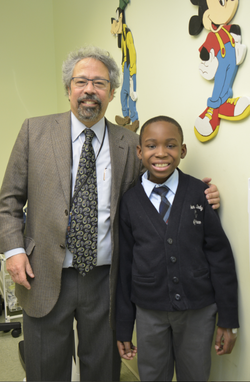Haplo Transplant Overview
General Information
- Bone marrow or stem cell transplant (SCT) is process that delivers high doses of chemotherapy to eliminate the patient's bone marrow and replace it with a new donor marrow that produces healthy cells, in place of the abnormal sickle cells.
- Here is printable list (.pdf) of stem cell transplant terminology for you to review with your doctor.
- Your insurance company will be asked upfront to pay for standard transplant costs including hospital stay, medications, doctor visits, and related donor costs. There is no charge for research tests. You or your child will not be paid to be in this study.
 Patient Kyle with Dr. Cairo
Patient Kyle with Dr. Cairo
Patient- What to Expect
- Preparation: You will undergo a series of medical tests (physical, labs, scans,etc) to assess your sickle cell disease and to determine if you are able to be in the study. About 2 months before transplant, you will begin taking medications (as an outpatient) to prepare your body for transplant.
- Hospitalization: About 17 days before transplant, you will be admitted to the hospital to receive specific medications, chemotherapies, and a single dose of radiation that will suppress your immune system and prepare your body for the donor cells. You will be at risk for infection during this time and will remain in the hospital.
- Day of Transplant: On this day, you will receive your donor's cells. They will be infused into you much like a blood transfusion.
- After Transplant: You will remain in the hospital for about 6-8 weeks as you wait for your new donor cells to start "working". After leaving the hospital, you will be followed in the outpatient clinic for 2 years after transplant. There are complications and side effects that can develop anytime after transplant, so frequent follow-up is very important.
Donor- What to Expect
- Preparation: You will undergo a series of medical tests (physical, labs, extensive medical history, etc) to determine if you are healthy enough to donate. If you are able to donate, you will receive injections (for 5 days) of a drug that will increase the number of stems cells (blood forming cells) circulating in your bloodstream. This is called mobilization.
- Donation: You will have a needle placed in the vein of each arm. Your blood will be drawn from the vein in one arm, passed through a machine that separates out and collects the stem cells, and the remaining blood will be returned to you through the other arm. Watch the National Marrow Donor Program PBSC donation video to learn more. This is a nonsurgical procedure.
- After Donation: Most donors feel "back to normal" a few days to a few weeks after donation.
Risks
Familial Haploidentical stem cell transplant has risks and does not work for everyone. The response of each patient enrolled in a trial can vary and you/your child may not respond to this treatment. You may have transplant complications or the sickle cell disease could come back.
Benefits
One potential benefit of this Familial Haploidentical transplantation is to permanently control or cure your sickle cell disease. Information may also be gained which may help future patients with sickle cell disease.
Risk vs. Benefit:
Understanding and weighing risks and benefits are important steps in your decision making process. Please discuss with your doctor or you may contact the lead study investigator here.
Familial Haploidentical stem cell transplant has risks and does not work for everyone. The response of each patient enrolled in a trial can vary and you/your child may not respond to this treatment. You may have transplant complications or the sickle cell disease could come back.
Benefits
One potential benefit of this Familial Haploidentical transplantation is to permanently control or cure your sickle cell disease. Information may also be gained which may help future patients with sickle cell disease.
Risk vs. Benefit:
Understanding and weighing risks and benefits are important steps in your decision making process. Please discuss with your doctor or you may contact the lead study investigator here.
Medical Disclaimer: The pages on this web site are for education and informational purposes only. Do not use this material to diagnose or treat a health problem; it is not a substitute for professional medical care. If you have concerns about a health problem, consult your doctor. This site is not meant as a substitute for the important healthcare discussions that should occur between an individual and their medical team. No liabiity is assumed by the Haplo SCD Consortium for any damages resulting from use or access to information posted on this website.
